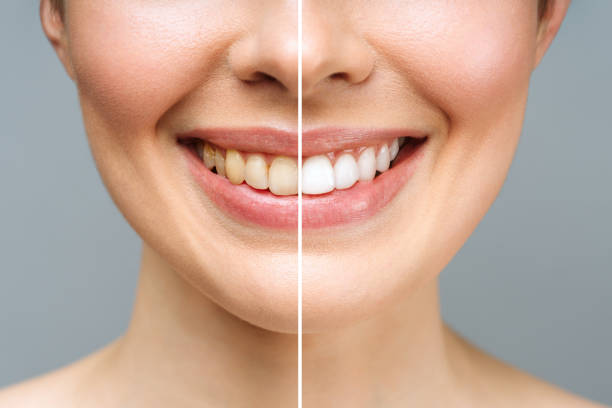
Teeth whitening is a common way to improve the look of your smile. Many people want whiter teeth because it helps them feel more confident. Bright teeth are seen as a sign of good health and cleanliness. There are many methods people use to whiten their Teeth whitening . Some are done at home, while others are done by dental professionals. This article explains the basics of teeth whitening, the different methods, how they work, and what to consider before starting.
What is teeth whitening
Teeth whitening is the process of making the natural teeth look brighter and whiter. This can be done by removing stains and discoloration from the surface. It does not change the shape or position of the teeth. The goal is to make the teeth look cleaner and more attractive. Teeth whitening can be temporary, so touch-ups may be needed over time.
Why teeth become stained
There are many reasons why teeth may lose their natural white color. Common causes include drinking tea, coffee, or red wine. Smoking and using tobacco also stain teeth over time. Some foods with strong colors, like berries or sauces, can cause stains. Poor oral hygiene may also lead to yellowing. In some cases, age or genetics can affect tooth color. Even some medicines can change the natural color of the teeth.
Types of teeth whitening methods
There are two main ways to whiten teeth. One is professional whitening done at a clinic. The other is at-home whitening, which includes products people can use on their own.
In-clinic whitening
This method is done by a dentist. A special gel is applied to the teeth. Sometimes, a light or laser is used to help the process. This method usually gives faster results. Most people can see a difference after just one session. The products used in clinics are stronger and more effective than over-the-counter options. Dentists also take care to protect your gums and other parts of your mouth.
At-home whitening
There are many options for whitening teeth at home. Some include whitening strips, gels, trays, or toothpastes. Whitening strips are thin, flexible pieces coated with a whitening gel. You place them on your teeth for a certain amount of time. Whitening trays are plastic mouthpieces filled with gel that you wear for a few hours. Whitening toothpaste has mild abrasives and chemicals to remove surface stains.
Natural ways to whiten teeth
Some people try home remedies like baking soda, hydrogen peroxide, or oil pulling. These methods may help with mild stains, but results are slow and not always proven. Using baking soda gently can help scrub off some stains. Oil pulling is the act of swishing oil in the mouth, often coconut oil, to remove bacteria and help improve oral health.
Is teeth whitening safe
Most teeth whitening methods are safe if used correctly. Professional treatments are usually safer because they are done by trained people. At-home products should be used as directed. Overuse of whitening products can cause harm. Teeth may become sensitive or the enamel may wear down. It is important to follow all instructions and avoid using products too often.
Who should avoid teeth whitening
Not everyone is a good candidate for teeth whitening. People with sensitive teeth, gum disease, or worn enamel should be careful. Whitening does not work on crowns, fillings, or veneers. It is best to speak with a dentist before starting any whitening method. Pregnant or breastfeeding women are often advised to wait before using such treatments.
How long do results last
The results of teeth whitening vary. With good care, the effects can last for several months. Avoiding dark drinks, smoking, and poor oral habits will help keep teeth white longer. Brushing twice a day, flossing, and regular dental cleanings also help. Using a straw when drinking colored drinks can reduce stains. Touch-up treatments may be needed every few months.
Benefits of teeth whitening
A bright smile often makes people feel better about themselves. It may help in personal and work situations. People who whiten their teeth often smile more and feel more confident. It can also give a cleaner and more polished appearance. A whiter smile may motivate people to keep up better oral hygiene.
Possible side effects
Some people may feel tooth sensitivity after whitening. This can happen if the product reaches the inner part of the tooth. Gums may also become irritated. These side effects are usually mild and go away after some time. If problems continue, it is best to stop using the product and ask a dentist for advice.
Tips to maintain white teeth
There are simple steps to keep teeth looking bright after whitening. Avoid smoking and drinking too much tea or coffee. Brush and floss every day. Rinse your mouth after meals. Use a whitening toothpaste once or twice a week to maintain results. Visit the dentist regularly for check-ups and cleanings.
Choosing the right method
The right teeth whitening method depends on your needs and budget. If you want fast results and have the money, professional whitening is best. If you prefer a slower and cheaper option, at-home kits work well. Natural methods are gentle but may take more time and show limited results. It is important to check the safety of any method you choose.
Conclusion
Teeth whitening is a helpful way to improve the look of your smile. Many methods are available, from simple home products to professional treatments. Each method has its own benefits and risks. Choosing the right one depends on your teeth, your goals, and your budget. Keeping up with oral care will make the results last longer. Always follow the instructions and avoid overuse. A whiter smile can bring more than beauty — it can boost your confidence and make a great impression.
Comments on “Simple Ways to Improve Your Smile with Safe Teeth Whitening Tips”